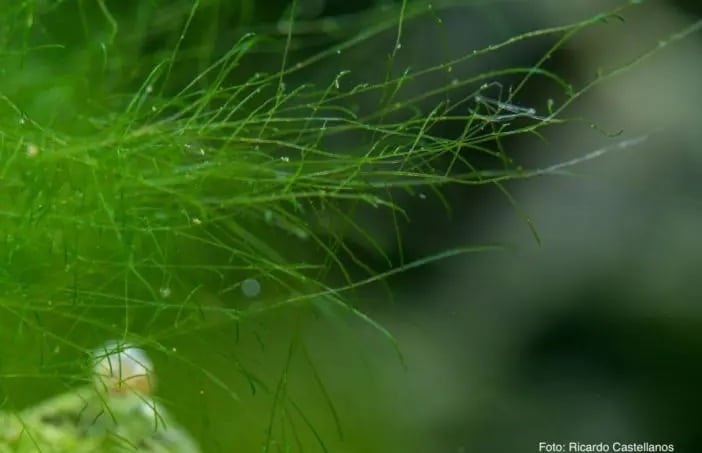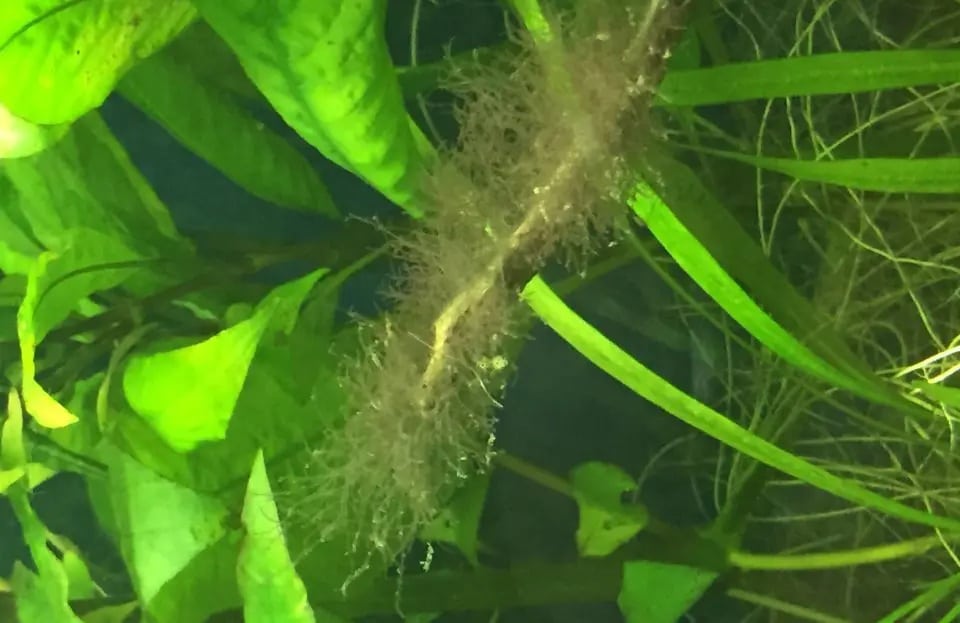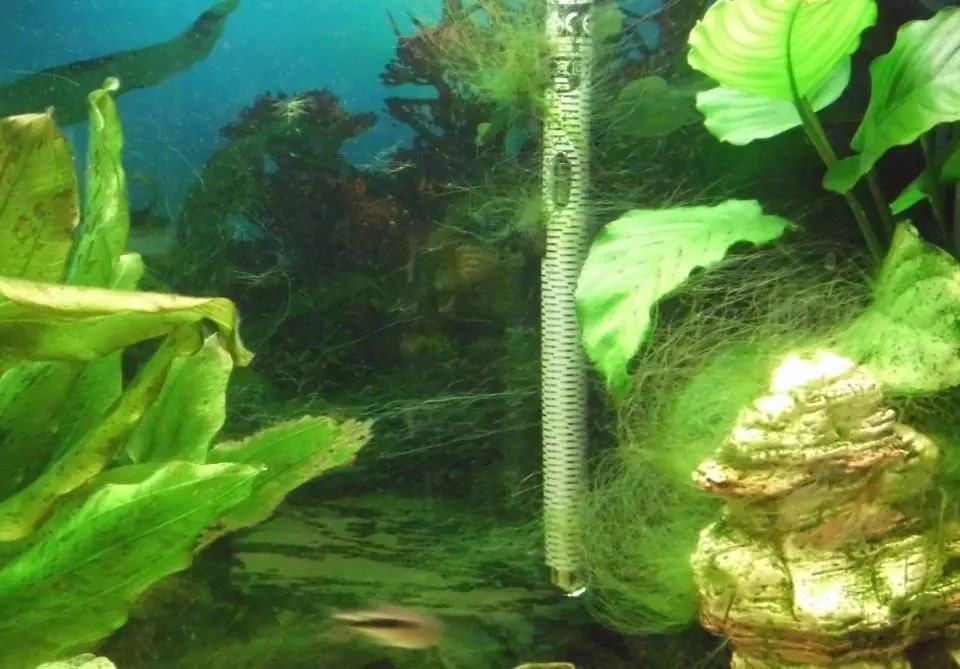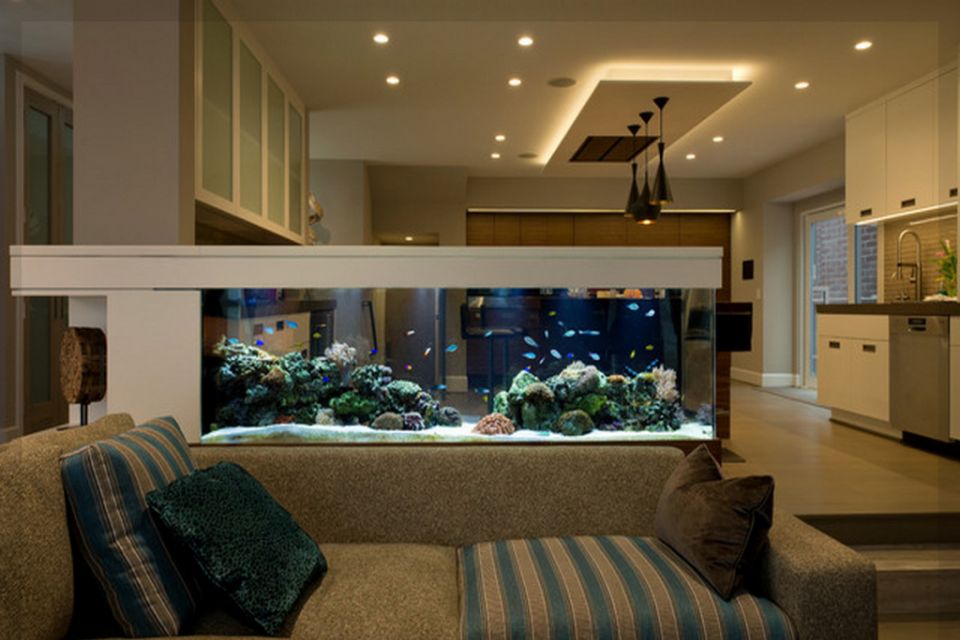
Table of Contents
thread algae – slimy, stringy, dirty
Thread algae belong to the genus of green algae. Together with the algae, they are most frequently found in German aquarium. True to their names, thread algae grow in wire or thread form. They can reach a length of up to 20 cm. The classic filamentous algae (soft and slimy) like to develop during the running-in phase of an aquarium and thus drive especially the newcomers among the aquarium keepers crazy. The light green, soft threads of this species float in the current, then get stuck to the decoration and plants and continue to grow in length from there. In case of excessive infestation they form bushy cushions, cobwebs or weedy little clouds that float through the tank. As soon as the plant stock claims the nutrients for itself, the algae problem usually solves itself.

Some filamentous algae species (harder and harder) are still present after the first break-in phase of a new aquarium. They literally spin themselves around whole groups of plants. They also feel at home on the roots and leaves of other plants, thus depriving their carriers of their livelihood. Thread algae in the aquarium are quite undemanding and can still develop when other plants have already stopped growing, for example due to a lack of nutrients. On the other hand, thread layers form especially when there is an oversupply of nutrients and light. This is why thread algae are often found in pools with slow-growing plants. It is particularly annoying that the filamentous algae cannot simply be filtered out in the aquarium. They will attach themselves to just about anything that offers them a surface to do so. The only way to get at this type of algae is to deprive it of its food.

Harmful and unsightly or perfect for the rearing tank?
Like so many things, the dose makes the poison. A slight growth of thread algae in the aquarium can keep the water values of the tank in balance. Filamentous algae in the rearing tank inhibit high concentrations of pollutants. A carpet of filamentous algae on the water surface serves as a colonisation area for many microorganisms and the oxygen bubbles also easily get caught in it. This provides sufficient food for the young fish and improves the nightly oxygen supply. In contrast, thread algae are less welcome in the show tank. With their green threads, they overgrow plants, roots and decorative objects and thus not only cloud the view of the lovingly designed interior, but also damage infested plants and the sensitive ecosystem of an aquarium. The undemanding nature of the thread algae allows them to literally grow where other plants have to hoist the white flag. The nutrient content of the water becomes increasingly unbalanced and in the end the living conditions for the actual inhabitants of the aquarium deteriorate: the fish.

Undemanding pests – why do thread algae develop in the aquarium?
The appearance of filamentous algae in the aquarium is actually a sign of the good quality of the water. From a nitrate value of 40mg per litre, algae have bad cards. Filamentous algae profit from a surplus of nutrients. It is therefore important that the growth of the aquarium takes up all nutrients for itself, instead of leaving something for the algae. Strongly growing aquarium plants deprive the algae of their nutritional basis. Adapted feeding of the aquarium inhabitants also prevents an excess of nutrients from forming. Another reason for the growth of filamentous algae in the aquarium is oversized lamps or the wrong lighting duration for a tank. Too long a lighting period, outdated tubes or direct sunlight increase the number of unloved visitors. Dead plant remains and fish excrement also contribute to the thread algae finding favourable conditions for rapid growth. The formation of filamentous algae, especially in the early stages of an aquarium, the so-called running-in phase, is usually due to an excess of light and fertiliser!

How do I get rid of her? – Removing thread algae in the aquarium
If you want to get rid of the unsightly thread algae in the long term, you have to put a little effort into researching the causes. Common means of algae removal only combat the visible symptoms of excessive algae growth. Without fighting the actual cause of algae growth, the green threads will soon start to appear again.
The basic principle is to be checked:
- Water values: too much or too little Co2, nitrate or phosphate
- Lighting: too strong, outdated, of too long duration? Reduce lighting time, possibly carry out a dark cure
- Position of the pool: windows in the vicinity? direct light from outside?
- Fish stocking: possibly reduce stock or use predators
- Feeding habits: if necessary, restrict, adapt to stock, observe one fasting day per week
Visible thread algae can be removed with various methods. Chemical aids such as Tetra AlgExit are effective, but should be seen as a last resort. A longer cure with chemical additives disturbs the microbiological balance of the aquarium. Aquatic plants and certain animal species do not tolerate the treatment and also die. If the climate in the tank is not changed fundamentally, the chemical club will have swung in vain and the old acquaintances will send their greetings again quite soon. Mechanical or chemical algae removal ultimately only fights the obvious. To finally get rid of an infestation with filamentous algae in the aquarium, several steps should be followed.

The thread algae on the collar – the step by step guide
Thread algae in the aquarium are stubborn, but with a little know-how, patience and tact, they too can be got rid of. Below you will find our step-by-step instructions to get rid of the unsightly algae in your aquarium in the long term.
Step 1: Location verification
The location of the aquarium is more important than can initially be assumed. For healthy growth and a good climate, the tank should be placed in a quiet place, protected from excessive daylight. Direct sunlight promotes algae growth! Even a nearby radiator disturbs the biological balance of a tank. Too much heat does not benefit the plants and animals. Healthy aquarium inhabitants in turn ensure healthy water values.

Step 2 : Check water values
The water values of the aquarium should be checked regularly using a test set (test laboratories). These are available in specialist shops but also online in the form of rod and droplet tests. The following values should be available so that an aquarium has a balanced climate and the thread algae have a hard time reproducing:
- Co2– about 20 to 25 mg per litre
- nitrate– not more than 30mg/l
- phosphate– 0,1 to 0,4mg/l
- Magnesium– >10 mg/l
- Potassium– 5 to 10 mg/l
What if these levels are too high? What is the reason for this?
Nitrate
Especially in Germany, tap water is often already too heavily polluted with nitrate, and every water change then favours an excess of nitrate in the pool. A too high nitrate value can also be traced back to too frequent, too strong feeding. Fish food that is not utilised or increased excretion of food by the fish causes the nitrate level in the water to rise.
Phosphate
Tap water should also be tested here, as it is often already heavily contaminated with phosphate! Plant fertilizers and many types of frozen and dry food also contain phosphate – especially frozen and live food, especially in smaller 60-litre aquariums, should be rinsed under clear water before use. One should reduce fertilization and feeding or switch to varieties with low phosphate content.
Co2
Too much carbon dioxide in water often indicates that the lighting is too high or too long. Unhindered sunlight also causes the Co2 value to rise. It is worthwhile to replace a possibly outdated lighting. During the running-in phase the pool should not be illuminated for more than six hours per day. Later an increase of 30 minutes per week is recommended. You can orient yourself by the following lighting time:
- strong lighting: 10 to 12 hours
- low light: 8 to 10 hours
If there is a shortage of Co2, a Co2 fertiliser plant can help. Such a system supplies the aquarium with compressed or biological carbon dioxide. The aquatic plants need this carbon dioxide for photosynthesis. They convert the Co2 into oxygen and thus supply the other aquarium inhabitants such as fish, shrimps and useful bacteria with this. Particularly demanding plants cannot get along with the usual amounts of Co2 emitted by the aquarium inhabitants. Without a Co2 system, the carbon dioxide value often remains below the optimal parameters. In order to promote the growth of the plants and thus deprive the filamentous algae of their nutritional basis, a CO2 system in the aquarium is practically unavoidable! Co2 also reduces the pH value of the water. Most inhabitants of an aquarium prefer a rather acidic environment to feel comfortable.

Step 3: Water change
Poor water hygiene can quickly lead to excessive algae growth. If the water is only changed irregularly, this causes an increase in waste products and this in turn causes phosphate and nitrate levels to rise. At least once a week 30 to 50 percent of the water should be changed. High nitrate and phosphorus levels can already be found in tap water. But don’t worry, because heavily polluted tap water can easily be mixed with standard osmosis water (water free of pollutants). Such water can either be purchased in pet shops for a small fee or simply be produced by yourself with a corresponding plant. The latter is especially in the long run the much cheaper option, especially as you don’t have to buy new osmosis water in the pet shop before every water change. With the partial water change the filter should be cleaned regularly. If the flow rate of the filter decreases significantly, it is time to clean it – we will show you how to clean the aquarium filter here.

Step 4: Remove thread algae manually
Especially the visible thread algae should definitely be removed manually, there are several methods for this. The so-called rod method has proven to be very effective: with an elongated object such as a skewer or a toothbrush, the algae are simply wound up and can then be easily removed. Soft thread algae can also be sucked off with a hose when changing water. Loose algae remains can be fished off by hand or with a sieve. Filamentous algae on the bottom of the pool can be carefully plucked out, but can also be vacuumed with a hose.

Step 5: Cleaning the decoration
Decorative items, stones or roots should be rinsed thoroughly under running water. On a chemical basis, hydrogen peroxide or liquid carbon dioxide are suitable solutions in which objects or plants can be placed outside the pool. But be careful, mosses for example do not tolerate this treatment! Also the direct spraying with the mentioned agents has a positive effect. Chemical agents for algae control must always be used exactly according to the manufacturer’s instructions and sparingly, because logically they do not only attack algae, but also the other aquarium inhabitants.
Step 6: Adjust fertilisation
Fertilizer is an important aid for the healthy and vigorous growth of aquatic plants. However, too much or too little has an effect on the climate and thus also on the growth of the unloved thread algae. Single component fertilizers and ready-made mixtures are available on the market. The fertilization of a freshly stocked aquarium or one that has been running for a long time depends on many factors: Number of plants, development, growth phases. A distinction is made between micro and macro fertilization. Especially at the beginning you should work with a significantly reduced iron fertilisation. If deficiency symptoms occur, the dosage can be slowly increased. A fertilization with macro elements depends on the type of substrate. Some soils withdraw nutrients from the water, others release more substances. If the soil has reached a certain saturation or has become thinner, the fertiliser addition must be adjusted accordingly. Neutral, unfertilised soil such as sand and gravel require fertilisation in the initial phase.

Step 7: Planting
Fast-growing plants are well suited to control filamentous algae in the aquarium. They compete with the algae for food. Once the plants have secured their position, the filamentous algae hardly have a chance. Well-known representatives include hornwort, water plague, swampweed or water duster. For the growth of such plants a Co2 plant is absolutely necessary. However, densely growing stands also need the right care. They may have to be thinned out or replanted. Always remove dead plant remains! A balanced plant ratio also protects against algae growth in the running-in phase. In specialist shops there are so-called anti-algae sets (mixture of collared and potted plants), which ensure a good climate in the pool from the very beginning.
Step 8: predators
Some fish, for example characins, loricariid catfish or even certain shrimp species like the thread algae on their menu. Amano shrimps in particular are not to be sneezed at and also eat the firmer, wiry representatives. However, only if little additional food is available. Racing or antler snails also prove to be very effective against all types of algae. However, too many algae-eating species also damage the other plants and can have a negative effect on water quality. As already mentioned above, plant, fish and snail populations should be coordinated in order to harmoniously support the sensitive balance of the pool and thus the water climate.
Conclusion – get rid of thread algae in the aquarium
Thread algae are a tiresome topic. Especially in the running-in phase, they ruin the hobby just discovered for newcomers to the field of aquaristics. The removal of visible thread algae is only half the job. In order to keep the unpleasant visitors away forever, research must be conducted into the causes of their emergence and the water quality of the tank must be adjusted. Regular checks of the water values, plant growth and fish population are mandatory to prevent the green pests from gaining the upper hand. Lighting times play a major role in the emergence of the unpleasant visitors. Regular water hygiene is also essential: a regular partial water change and cleaning of the filter should definitely be on the schedule. Chemical algae remedies should only be seen as a last resort; they not only combat thread algae but also damage the biological balance. Checking the water values with a test set is essential and should be carried out regularly. With the tips mentioned here and the step-by-step instructions, thread algae in your aquarium should soon be a thing of the past.



